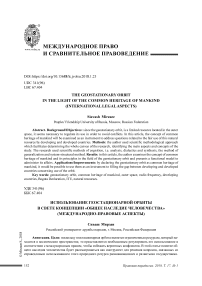The geostationary orbit in the light of the common heritage of mankind (international legal aspects)
Автор: Mirzaee Siavash
Журнал: Legal Concept @legal-concept
Рубрика: Международное право и сравнительное правоведение
Статья в выпуске: 1 (38), 2018 года.
Бесплатный доступ
Background/Objectives: since the geostationary orbit, is a limited resource located in the outer space, it seems necessary to regulate its use in order to avoid conflicts. In this article, the concept of common heritage of mankind will be examined as an instrument to address questions related to the fair use of this natural resource by developing and developed countries. Methods: the author used scientific methodological approach which facilitates determining the whole canvas of the research, identifying the main aspects and concepts of the study. The research used scientific methods of cognition, i.e. analysis, dialectics and synthesis, the method of generalization and system-structural method. Results: in this article, the author examines the concept of common heritage of mankind and its principles in the field of the geostationary orbit and presents a functional model to administer its affairs. Applications/Improvements: by declaring the geostationary orbit as common heritage of mankind, it would be possible to use them as an instrument to filling the gap between developing and developed countries concerning use of the orbit.
Geostationary orbit, common heritage of mankind, outer space, radio frequency, developing countries, bogota declaration, itu, natural recourses
Короткий адрес: https://sciup.org/14973492
IDR: 14973492 | УДК: 341(96) | DOI: 10.15688/lc.jvolsu.2018.1.25
Список литературы The geostationary orbit in the light of the common heritage of mankind (international legal aspects)
- Abashidze A.Kh., Solntsev A.M., Chernykh I.A. To the 150th anniversary of the establishment of the International Telecommunication Union -a Specialized Agency of the United Nations. Eurasian Journal of Law, 2015, no. 7, pp. 55-61.
- Baslar K. The Concept of the Common Heritage of Mankind in International Law. Martinus Nijhoff Publishers, 1998, vol. 30.
- Christol C.Q. The Legal Status of the Geostationary Orbit in the Light of the 1985-88 Activities of the ITU. Proceedings of the Thirty-Second Colloquium on the Law of Outer Space, 1989.
- Herter C.A. The Electromagnetic Spectrum: A Critical Natural Resource. Natural Resources Journal, 1985, vol. 25 (3).
- Kiss A. The Common Heritage of Mankind: Utopia or Reality? International Journal, 1985, vol. 40 (3).
- Mirzaee S., Abashidze A.Kh., Solntsev A.M. The Concept of Common Heritage of Mankind in the Advisory Opinion of 1 February 2011 by the International Tribunal for the Law of the Sea. Journal of Advanced Research in Law and Economics, 2017, vol. 8 (2).
- Mirzaee S. Outer Space and Common Heritage of Mankind: Challenges and Solutions. RUDN Journal of Law, 2017, vol. 21 (1).
- Riddick D. Why Does Tonga Own Outer Space? Air & Space L., 1994, vol. 19.
- Stone Ch.D. The Gnat is Older than Man: Global Environment and Human Agenda. Princeton University Press, 1995.
- Talaie F. Legal Issues concerning the Radio Frequency Spectrum and the Geostationary Satellite Orbit. Austl. International Journal, 1998.
- Tronchetti F. The Exploitation of Natural Resources of the Moon and Other Celestial Bodies. Brill, 2009.
- Wihlborg C.G., Per Magnus W. Outer Space Resources in Efficient and Equitable Use: New Frontiers for Old Principles. The Journal of Law and Economics, 1981, vol. 24 (1).


